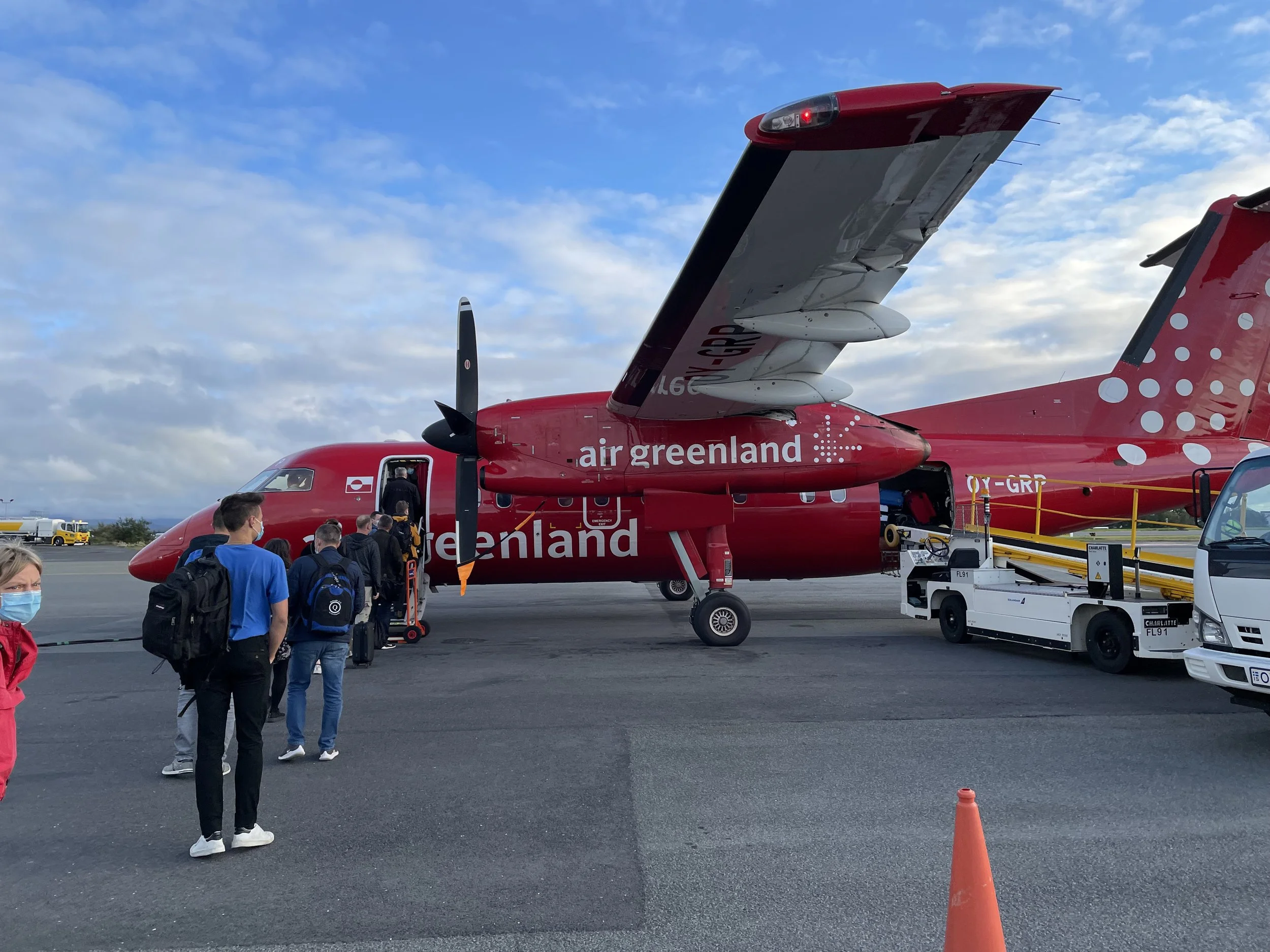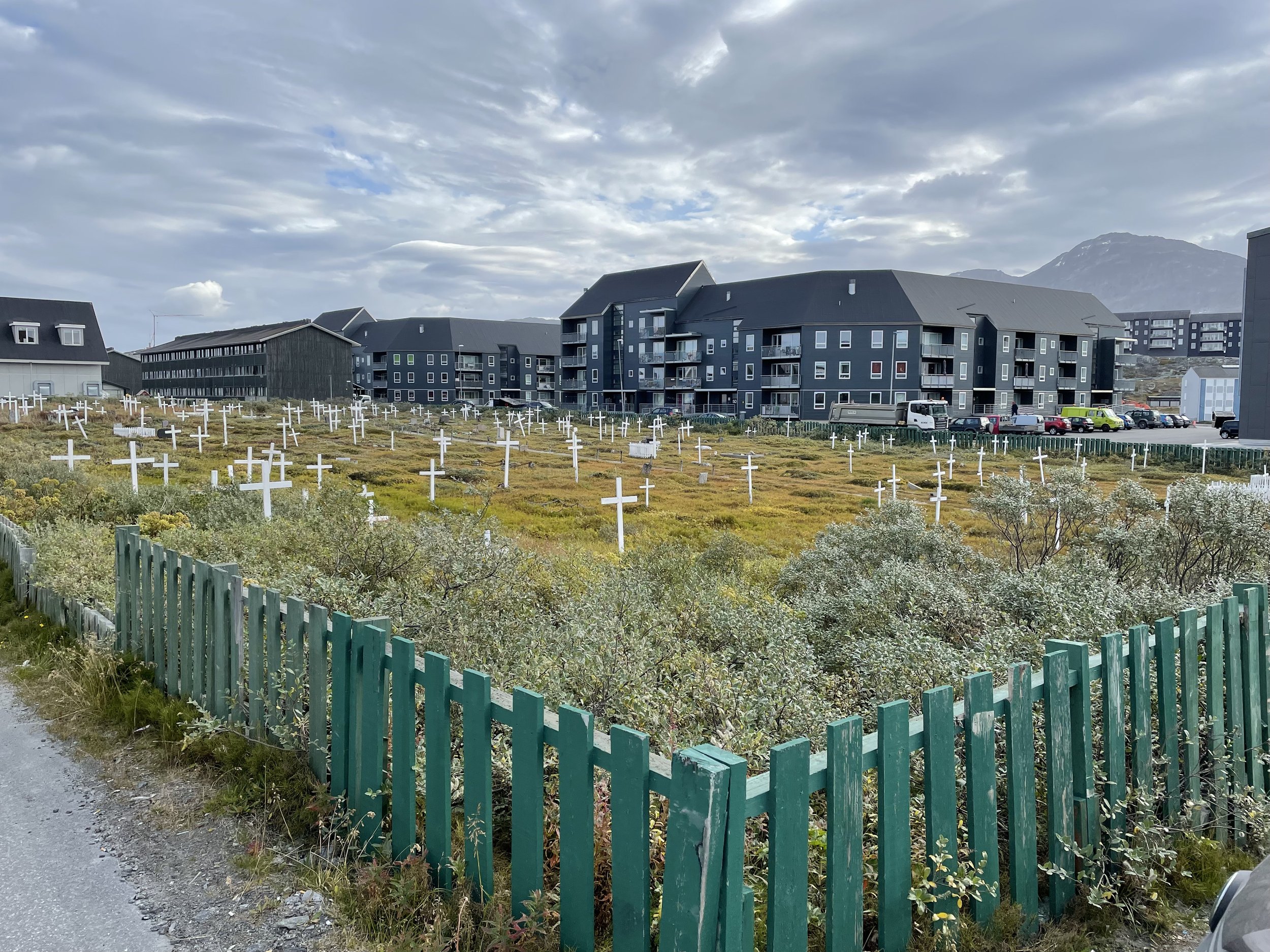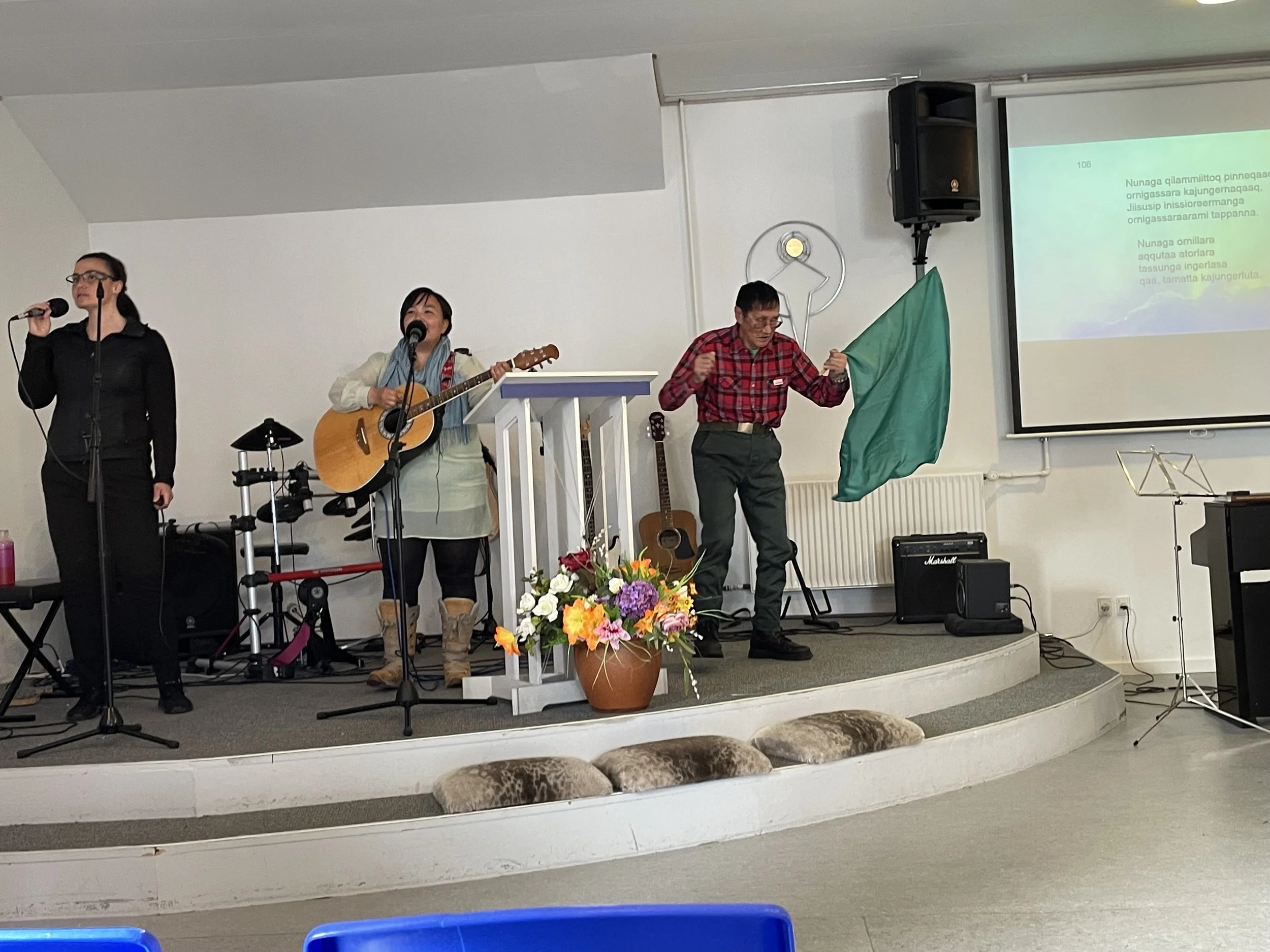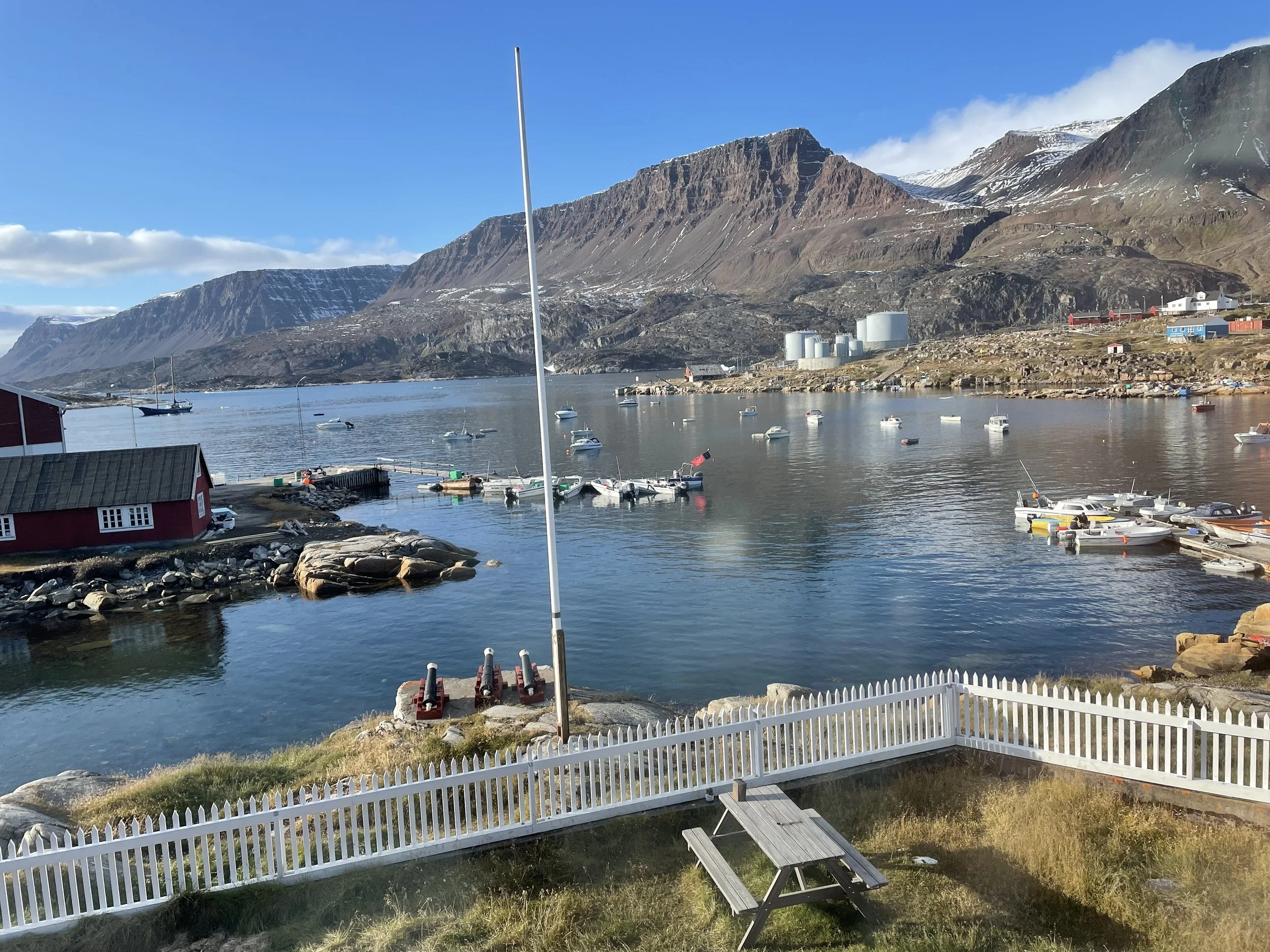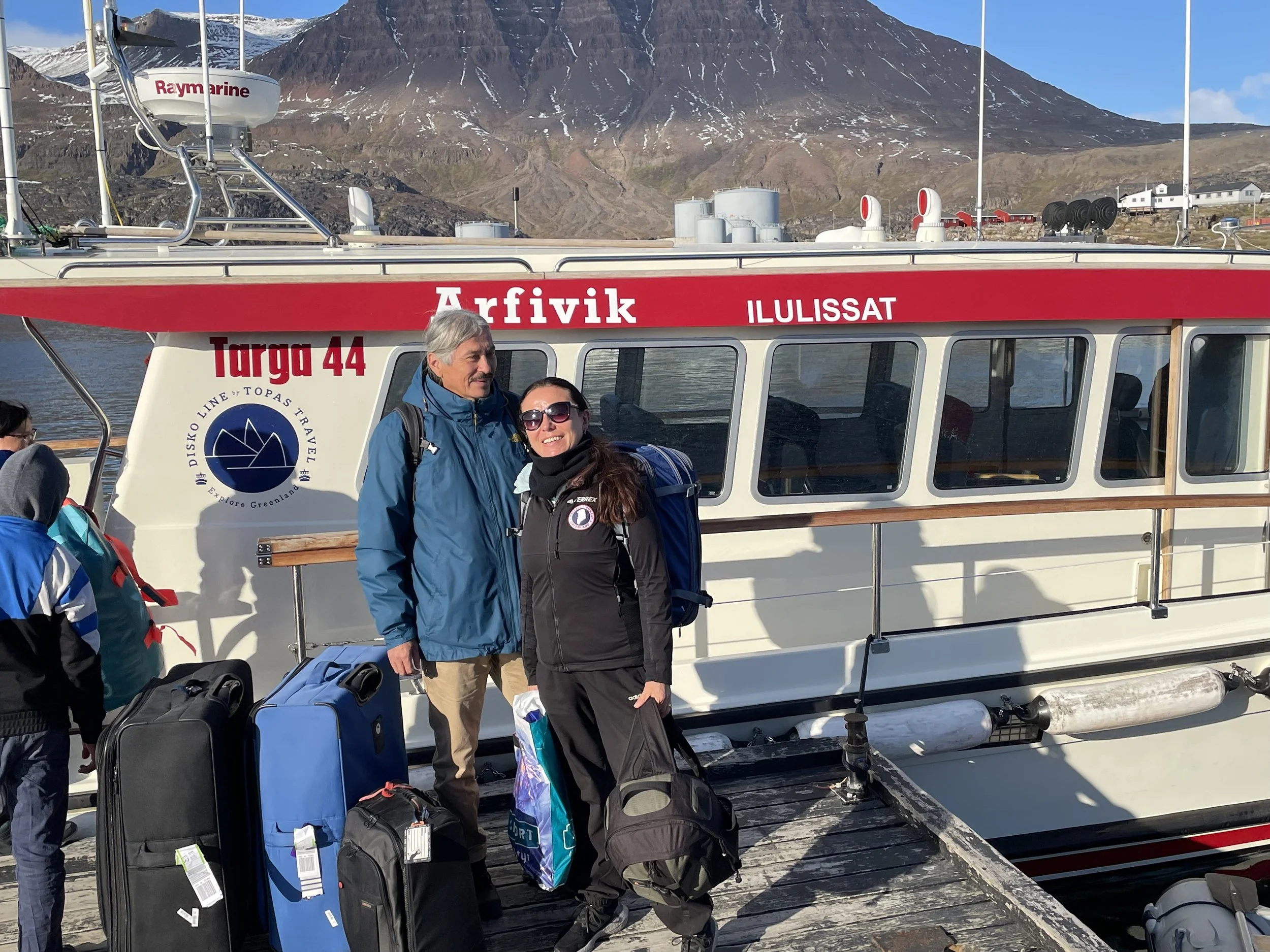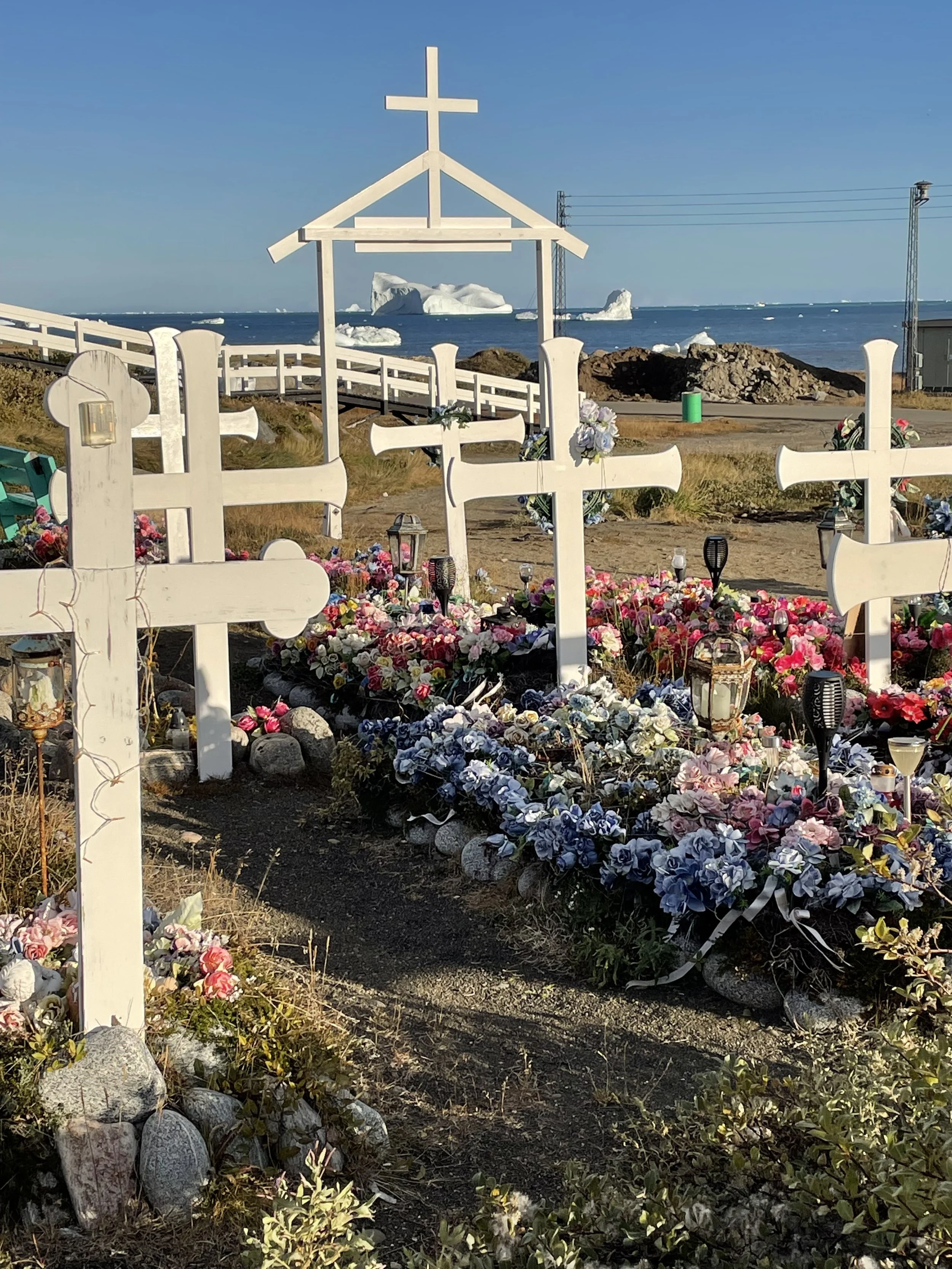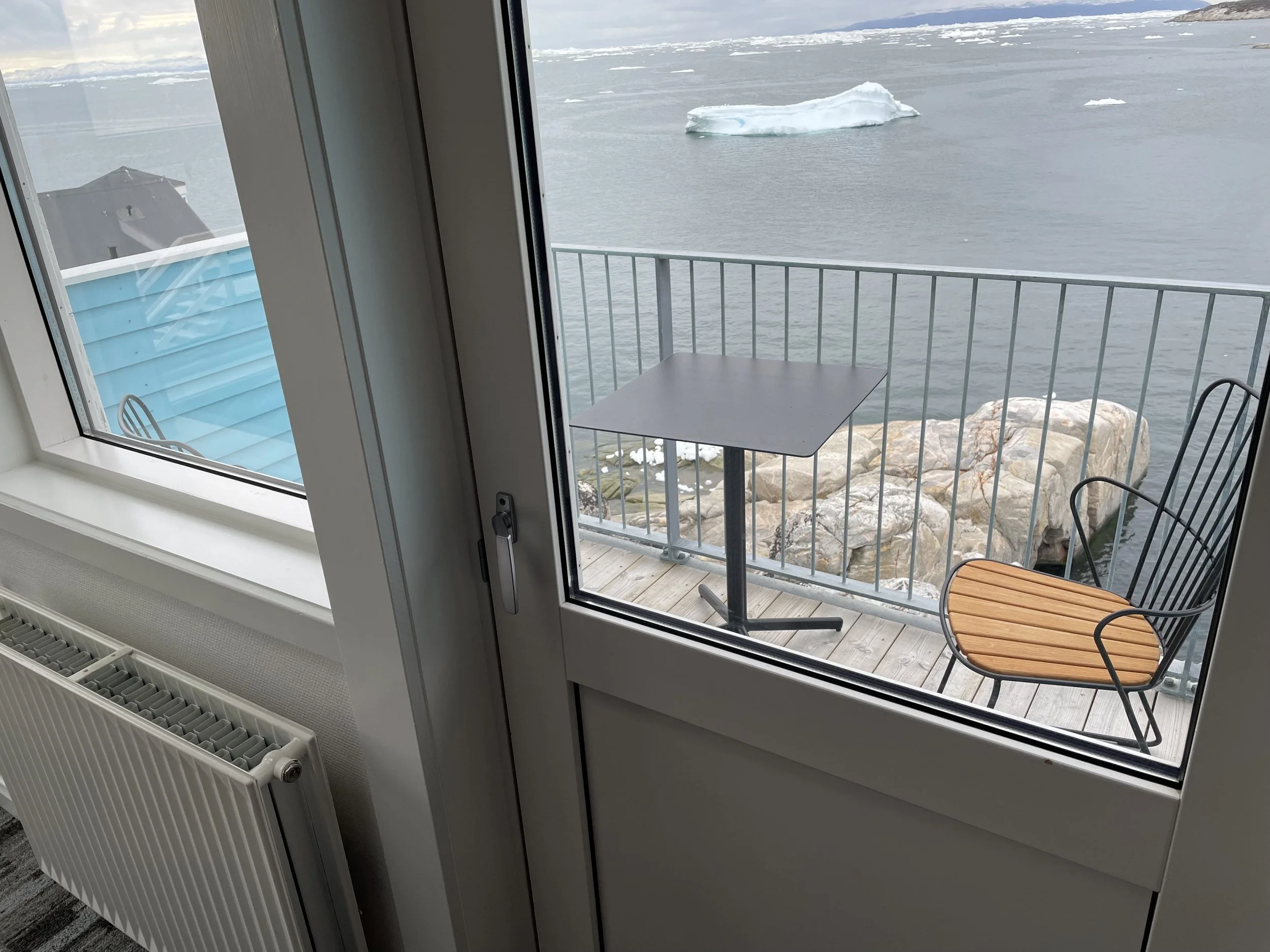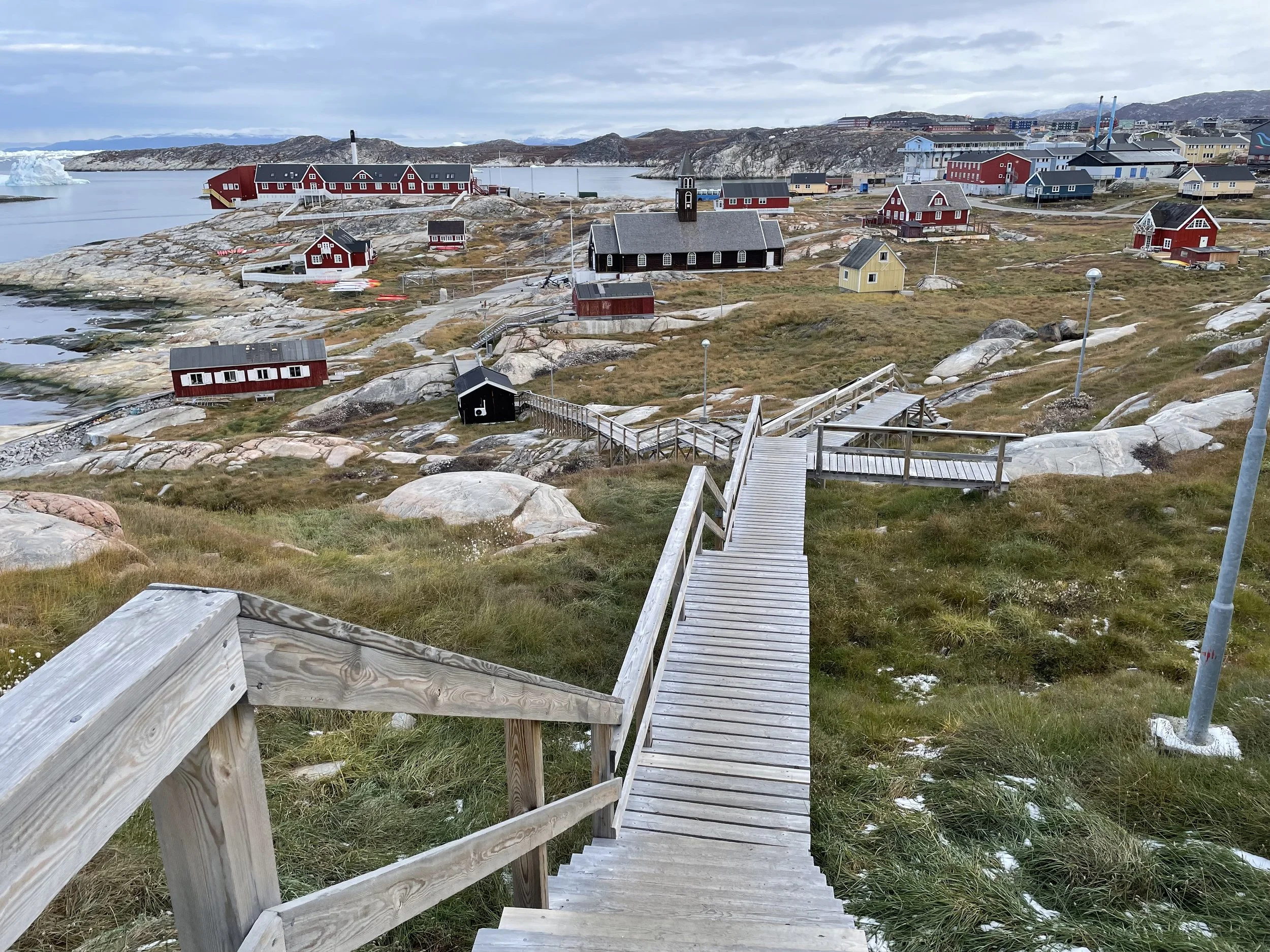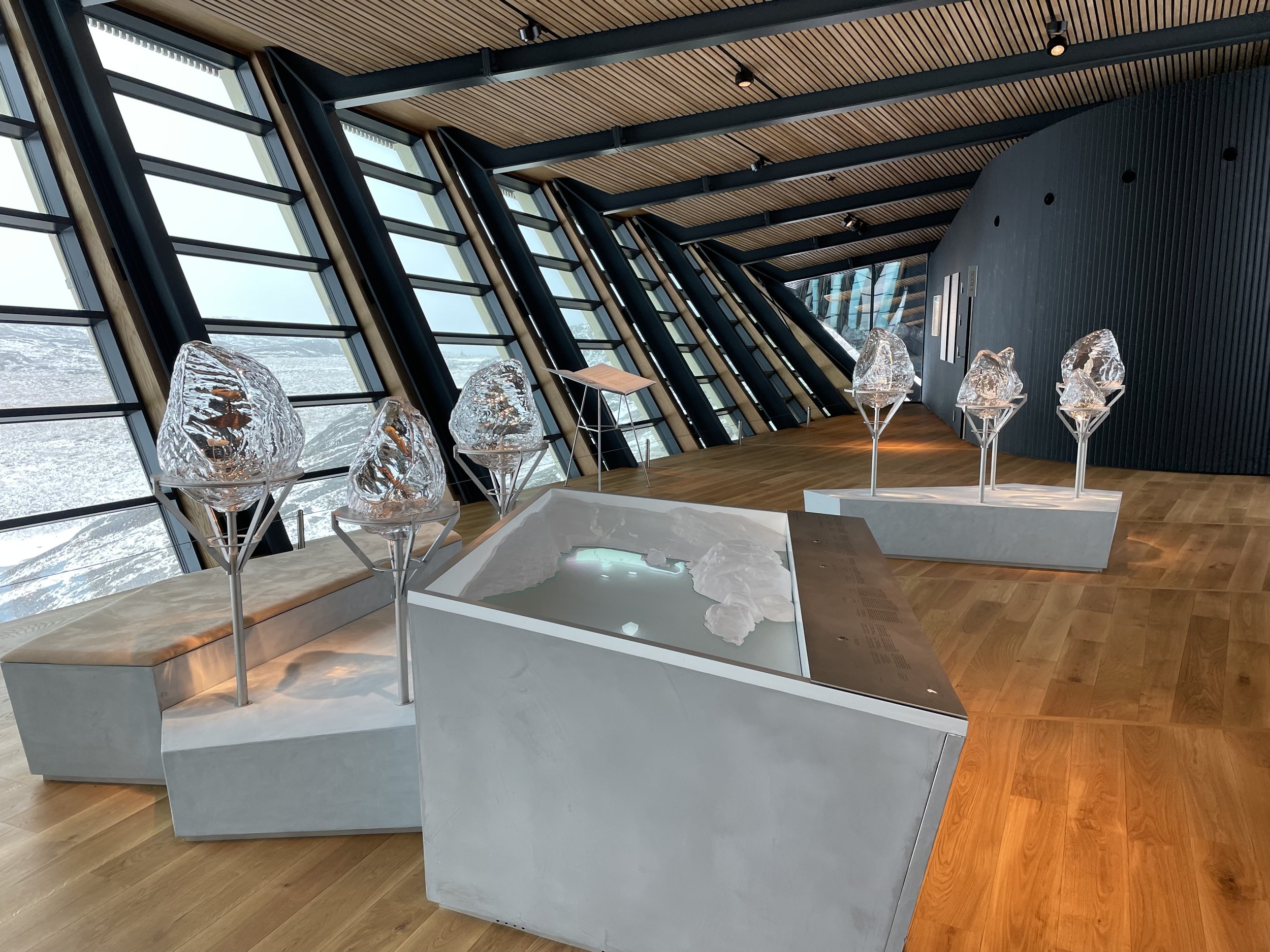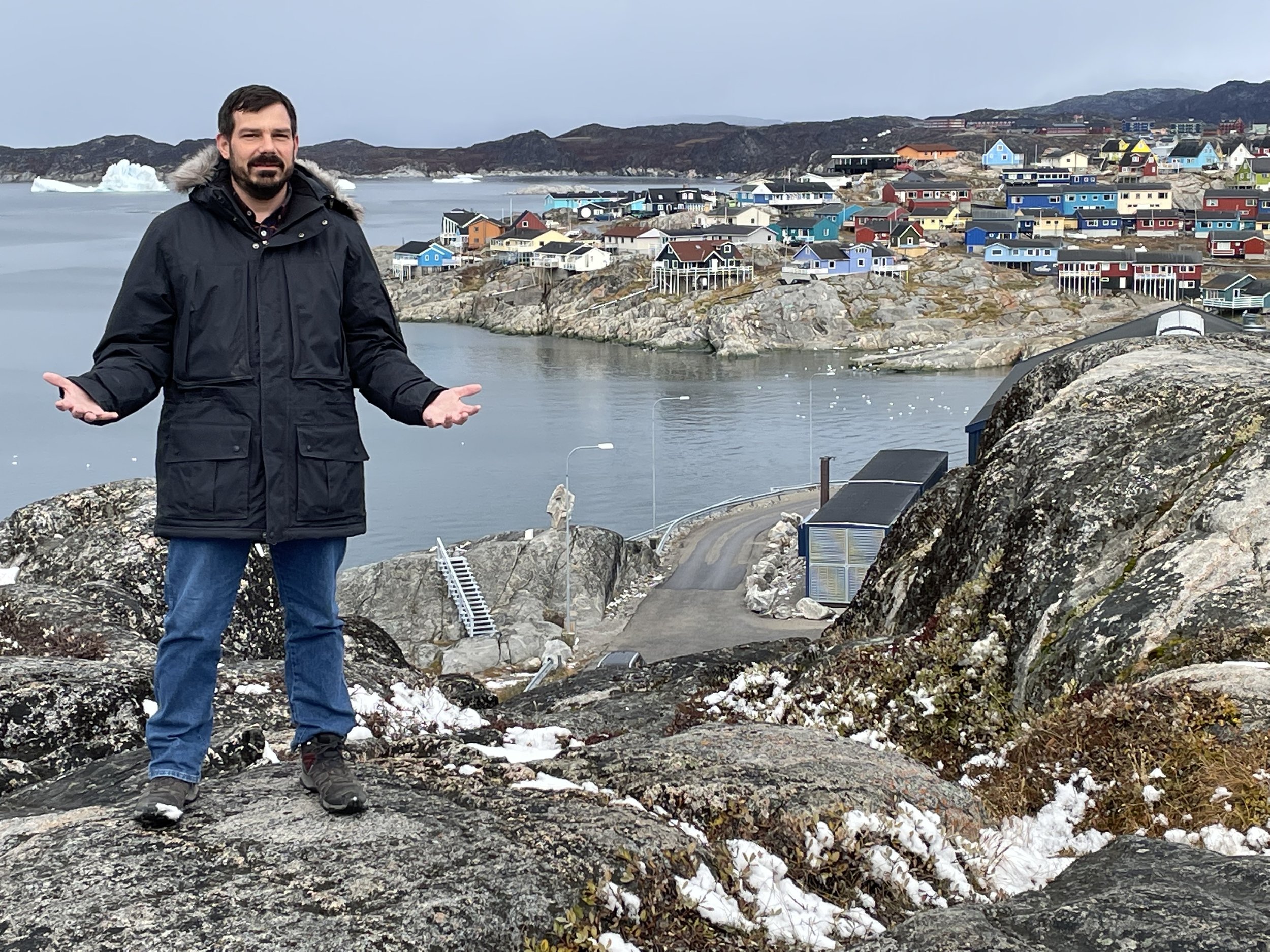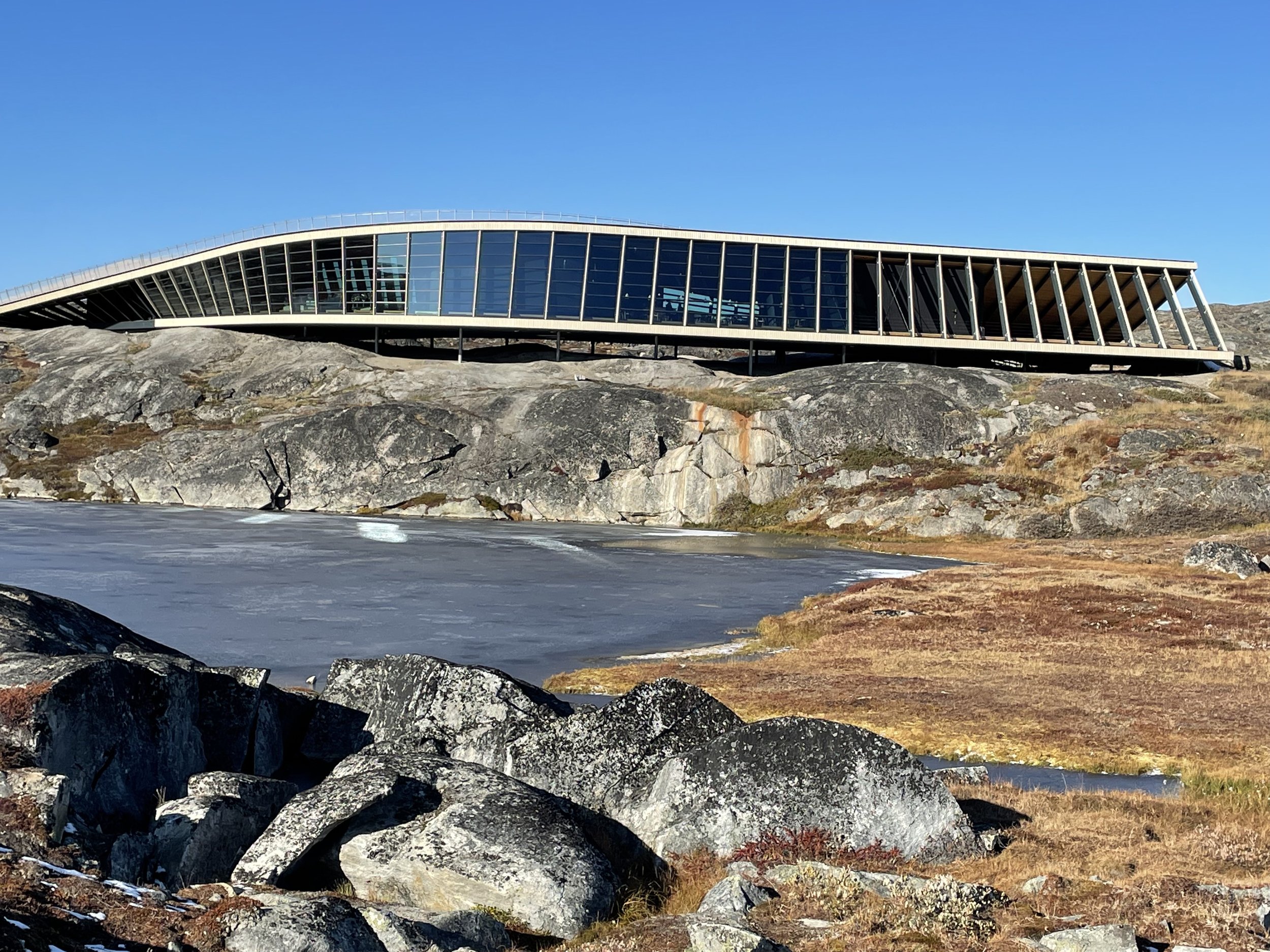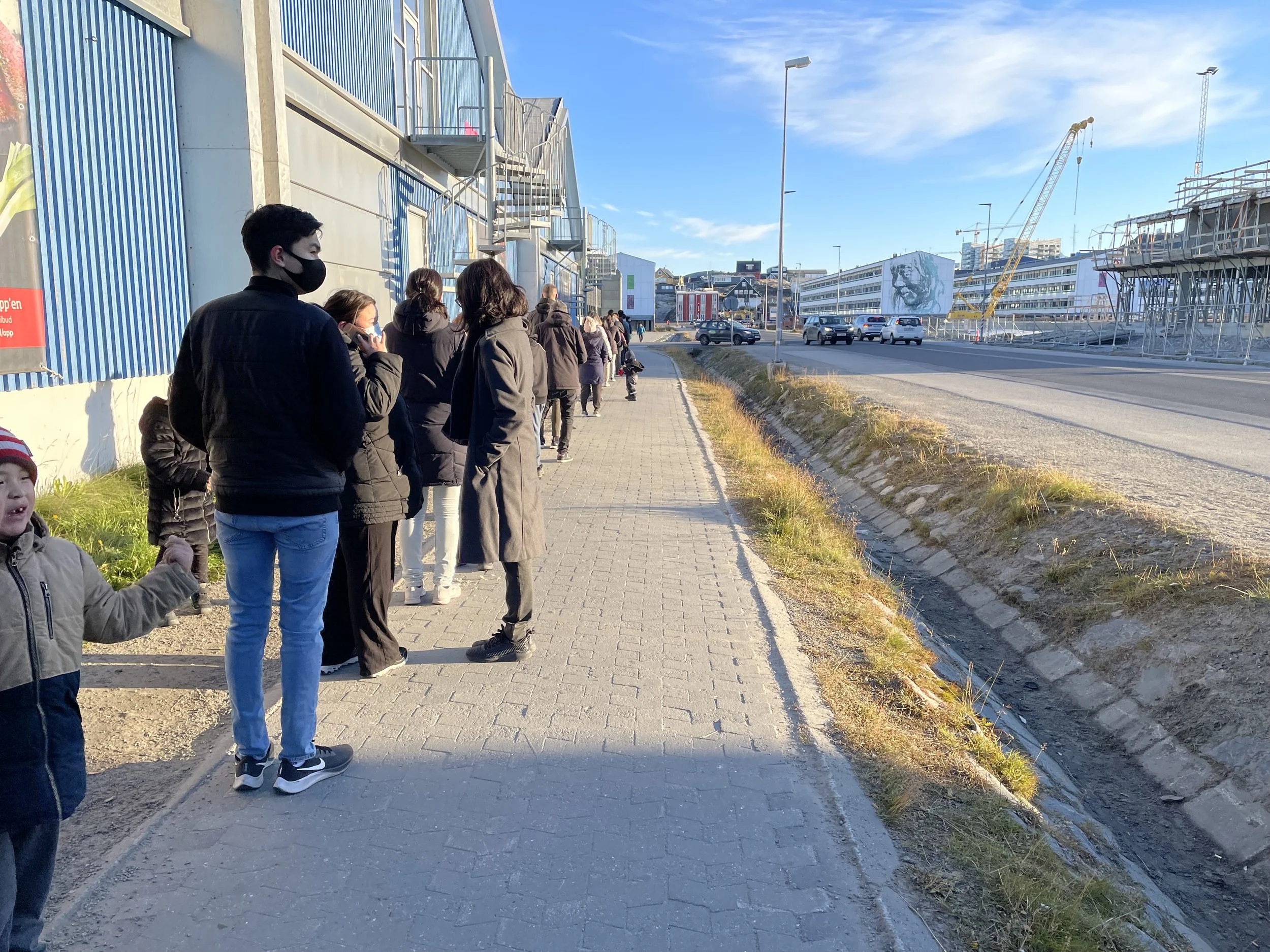What I learned about Greenland (in 7 days)
Inquiring minds might want to know about a trip I took 5 months ago that I’ve never described. Well, now that my travel story about the Icy Island ran in Newsweek last week, I can share a blow-by-blow account of my adventures there. I’ll start with my departure from Reykjavik, as one has to go via there or Copenhagen to fly to Greenland. Hopefully all that will change in 2024 when 2 new international airports open in Greenland, hopefully for traffic from North America. I’ve been wanting to travel to this spot for at least 10 years and finally the opportunity presented itself, as the country had just opened an amazing museum dedicated to climate change and the history of ice in Ilulissat, a city midway up Greenland’s west coast. I knew I could sell such a piece, so after a lot of negotiation with the country’s tourism department, Visit Greenland, I got to go in September.
Air Greenland reflects the colors of the national flag: Red and white.
Saturday, Sept. 11 - The departure lounge for Air Greenland was the international arrivals room at Iceland’s domestic terminal; a space out of the 1960s with black linoleum floors and silver seats. I look at the odd assortment of people on my plane. Most chatted with each other in Danish but the building crew and the employees at Icelandair’s terminal conversed in English. A lot of the passenger looked like hiker/backpacker types with their orange North Face packs, boots and puff ski jackets; usually the first to get to an exotic destination. For the Danes, going to Greenland like us going to the North Slope; it takes some toughness and fortitude to carry it off.
The Dash-8 turboprop we were flying was not full (interesting in that I’d been told these flights were hard to get), so we flew through the clouds for 3 hours 45 minutes until we were hovering over the west coast, an expanse of lava-black rock poking up through a creamy-blue sea at dusk. The terminal at Nuuk, the capital, was a very informal affair and no one checked our passport or Sumut (immigration) docs or anything – we all just walked out into the cold evening air. The gravelly/dirt parking lot looked quasi-Alaskan and the whole city was built on huge rocky outcrops with nary a tree in sight.
A cemetery in Nuuk.
Meeting me was a trim, athletic-looking Icelandic man who had been working out of Copenhagen until this job came open and he jumped at the chance to live in Greenland. This was Hjörtur Smårason, the new head of Visit Greenland which has 13 employees. It was also subsidizing generous portions of my trip, which would have otherwise been unaffordable. Greenland is crazy-expensive. He took me to a tapas restaurant – Tapasimut - across the street from Hans Egede, my hotel, and we munched on musk ox and tuna selections. I was amazed at the sophistication of the place and the fresh veggies – cilantro! – they had available. We talked until almost 10 all about the cool places around the world we knew and what the vision was for Greenlandic tourism. Finally the restaurant began turning off the lights, so we left.
Sunday, Sept. 12 – I slept in, then enjoyed a nice Scandinavian-style breakfast on the 5th floor of this sumptuous hotel. I stepped out into the 39-degree weather and was nearly knocked down by the wind, a result of Hurricane Larry, a hurricane that had somehow snuck up to Canada, is then headed east. The downtown seemed deserted, so I walked briefly toward the “old” Lutheran church but no one was there. I headed the other way, praying I’d somehow run into the Pentecostal church I’d heard about. I headed past some closed shops, hit one road, then turned left on another where I thought the church would be. I headed south and began climbing some steps, then glanced into the windows of a nearby blue building. I saw several people seated listening to something and, it being Sunday morning, I figured this had to be a church. Sure enough, it was the place I was looking for and blessedly warm. The service, which started at 11, was about 90 minutes long and was being led by a Danish man who, it turned out, had pastored there until 2018 before turning it over to a local guy. But the native pastor ended up splitting the church, which lost half its members. (I counted 40-50 in the room and the Dane said attendance was closer to 60). One of the ceremonies they had was welcoming back one of the departing couples. They also consecrated three elders to run the church and look for a new pastor. Fortunately, no one seemed to notice – or care – that I was taking photos. In fact, no one even greeted me except for the Dane (his name was John Østergaard Nielsen), who ended up giving me a very nice interview afterwards.
Worship leaders at Inuunerup Nutaap Oqaluffia, a pentecostal church in downtown Nuuk.
Then I wandered down toward the waterfront, climbing the rocky mount on which stood a statue of Hans Egede, the Danish missionary who founded modern-day Greenland in 1721. It was so windy, I truly thought I’d lose my footing; moreover the sand was getting into my contacts so I had to veil myself with a dark blue scarf like a Bedouin. I learned later there was a museum and all sorts of shops by the waterfront but everything was closed, it being Sunday. On my way back, I found the Nuuk Centre, a mall and then across from the hotel, another mall, which is where I spent the afternoon staying warm and eating an early dinner for about $8.
Then Helene Steffensen from Visit Greenland picked me up to give me a driving tour of Nuuk, which helped me get the lay of the land. She introduced me to the suburb of Qinngorput, just east of town and with the jazziest apartments. Much of Nuuk looks like container heaven; they are everywhere and the apartments all strung together in a line of concrete and windows and bright paint, looked faintly Soviet in terms of cold-weather lodging styles. But there were all sorts of cranes – I counted more than 10 in the sky as the city is expanding in a major way and at least the newer apartments have a far more human look to them.
A view of the bay at Qeqertarsuaq on Disko Island
Monday, Sept. 13 – Adventures continue, some of which I could do without. Caught an early morning flight to Ilulissat (the city 300 miles north of Nuuk where I’d be spending a few days) but didn’t realize we had to deplane at the Kangerlussuaq airport for 20 or so minutes because the stewardess mumbled the English instructions. I then arrived in Ilulissat only to find out there were no taxis at the airport and I had no idea where to call for one. I begged a ride into town from a friendly Danish businessman, whose taxi dropped me off at the dock of Disko Line, the boat service that was supposed to take me across the bay to Disko Island. I soon learned that, despite my itinerary, there was no morning boat to Disko Island. And no one there spoke very good English. I was getting frantic. Finally, a few other people walked up, and I asked one local woman, named Johanna, to call the Disko office. She learned the ride had been moved back to 2 pm. At the same moment, I got a text saying the same thing because of “weather conditions,” which was nuts; there was no wind and temps were 34º. Apparently Disko Line has a habit of unexpectedly changing boat departure times at the last minute. Some more tourists came, so we were all left standing there, trying to figure out what to do for 3.5 hours. The local woman gave me a ride in her pick-up to Cafennguaq, a very nice place on Mittarfimmut Aqq, which is the road into town. Didn't look like much from the outside but was spacious and warm inside with good internet and helpful staff.
Around 1:30, I set off to look for an ATM, then walk to the dock, when who should drive up but Johanna who took me first to the bank, then to the dock. The boat ride to Disko Island, about 2 hours long, was stunning. The sun had come out and there we were in the bright sun, sailing across this luminous bay with icebergs, some the size of multi-story buildings. The boat ran over ice pieces constantly so it was like driving on a rocky road. As we got further toward Baffin Bay, the ride got very rocky and I felt quasi seasick. Meanwhile, I’d gotten into a conversation with the most fascinating couple: Galya Morrell, a celebrity artist and Arctic issues activist and Ole Jorgen Hammeken, a Greenlander who’s a top-notch dog sledder. We got into a very animated conversation on the boat and I ended up interviewing her about some things. Then I found out he was a second cousin to Ove Berthelsen, the owner of SikuAput, a tourism business on the island, whom I’d emailed about giving me a tour. We agreed to meet that evening chez Ove.
Galya Morrell and Ole Jorgen Hammeken on the dock at Qeqertarsuaq
We landed at Qeqertarsuaq, the main town on the island. I entered the Disko Hotel, a lovely and new place with reception folks who spoke English, and a room that was kind of like a high-end hostel – very clean – and came with a downstairs kitchen. I then wandered about the island in the bright afternoon sun, enjoying the fact that, because of the cold temps, there were no mosquitos which apparently are everywhere during the summer. The beautifully painted bright homes, the icebergs floating near the beach, the sounds of the sea; it was part Maine coastal village, part Alaskan fishing harbor and part iceberg park alongside volcanic island. I walked along the black sand beach, past howling sled dogs and furry obnoxious pups and other signs of an Arctic settlement: Pipes, lawn equipment, wood stacks, toys laying about around the houses. There was still some snow on the ground, believe it or not. I was at 69º latitude, one degree below that of Prudhoe Bay.
The cemetery in Qeqertarsuaq with icebergs.
Then I wandered about the fake flower-bedecked cemetery, realizing with a start that several of the graves held fairly young men in their early 20s. Were these some of the suicides this place was known for? My blood ran cold. Returning to the hotel restaurant, I stuffed myself on a dinner of snow crab which, along with the wine and salad and warm bread, came to about $49, not bad. Snow crab looked and tasted like Alaskan king crab; I wish they’d supplied a crab cracker, as I had to use my teeth.
Ove then dropped by to pick me up for dessert and coffee and I and Ole and Galya and Ove’s wife had the loveliest 2 hours talking about the Arctic and their lives and the fact that Ole and I and the wife are all 65 this year. Ole even played a song for us on the guitar. One thing I’m finding out about this kind of travel; when you go to edgy places, you meet all the interesting people (scientists, journalists, researchers, military) who aren’t just touring but who are there before the crowds show up.
Sept. 14, Tuesday – Ove picked me up for a walk about town, which turned out to merely be up to the bridge over the river near the tent camping space and just beyond the soccer field. (It would have been longer but the boat company had moved up the departure time by several hours, essentially ruining my hopes of seeing much of the island). He said that a huge part of the town’s population was kids but by the age of 15, they have to move to another town to go to high school. It was lovely and sunny as we walked and clambered about. The boat came to get us at 11:30, which is when I learned that our ride would be closer to 4.5 hours rather than 2.
The balcony and view outside my window at Hotel Icefjord was stunning- unfortunately the 20-degree temps made outside lounging impossible. But those icebergs…
Of course, I’d received no notice of the extra ports of call to various cities on the southern end of the bay: Aasiaat, Qasigiannguit and Ilimanaq, none of which looked all that impressive, although all we saw were their waterfronts. But it was a bitterly cold day with occasional snow flurries so I slept during much of the ride as the boat was warm. Finally got to Ilulissat around 4 and was picked up by the Icefjord Hotel folks where I was given a lovely corner room with stupendous views of the bay. There was a lovely balcony, even, but in 20-degree-some weather, I wasn’t going to sit out there. Other than the icebergs, it felt like I was in Greece with all the lovely water views. The dinner at the hotel was a smash-hit too – beautifully done. Only sour note was the extremely minimalist bathroom with no Kleenex, no water glasses, a super-odd shower with no shampoo, lights I could not figure out how to turn on and a water nozzle that had no discernable way of turning on and off. Oh, and only 1 outlet that was near a desk whereas most hotels have two. So I have to take turns charging my phone and my laptop. Guess I’ll wait to wash my hair back in Nuuk.
The historic part of Ilulissat includes Zion Church (dead center) and the local hospital (red building in the upper left. Boardwalks connect buildings all over town; apparently they hold up best in the snow and ice.
Wednesday, Sept. 15 – At 9 a.m., the local destination manager, Asbjørn Bargsteen, showed up to give me a tour about town. We dropped by the historic Zion Church (which was being renovated), then the waterfront (a bunch of dead seals there), a fish market, a craft shop, another Lutheran church (much prettier with a blue interior and exterior) and then wended our way to the Icefjord Centre past a field of sled dogs (chained to houses like in Alaska) and their unchained puppies. Asbjørn had just moved from Denmark a few months before and he said most Danes will put in a year or two – and sometimes a half year – at a Greenlandic job, then move back. The pay is good – like Alaska – but they don’t want to stay. The snow was falling and so the center looked beautiful out in a desolate, rocky area near a pond. The opening of this unique museum on the history of ice and climate change was the major reason for my trip and the center of any stories I’d be writing about the country. There are lots of articles out there on this unusual museum but very few of the writers had been to Ilulissat to visit the place. I didn’t know of any U.S. travel writers who’d gotten there before me.
The inside of the Icefjord Centre. Some of the exhibits are in those teardrop-shaped ice crystal cases.
We walked inside and I interviewed Elisabeth Momme, the director of the centre. We drank coffee at these pine wood tables in the midst of this stark reception area. The rest of the centre was in neutral tones with occasional soft upholstered white cushioned benches. There was a sound room where you could hear sounds of ice cracking from microphones placed at various research centers and known glacier fields. The whole center was about ice; its history and that of the peoples living near it. The focus of my articles was going to be this amazing museum, so I took a ton of notes.
Then I repaired to the local Baptist church and a story that I’ve waited more than 10 years to write. I’ve long been fascinated with what and how a non-Lutheran would set up shop in a Lutheran country like Greenland. The Ilulissat Baptist church was a grey building down the road from the museum, and that is where I met Chris and Carole Shull, the pastoral couple who started the church 14 years ago. Also met their kids, drank more coffee and interviewed them for what I hoped would be a smash hit religion piece that I’d call “The Pastor at the Top of the World.” (Which was the real headline of the piece, when it ran in October in Newsweek). The story of how they overcame so many challenges to get a foothold in this country was dramatic. The family had been in the States during the summer on sabbatical, so I’d interviewed Chris the month before on the phone at length about the church with the agreement I’d get to Ilulissat to finish the piece. They were Independent Baptists; a subset that few reporters write about because they tend to avoid the media. Jerry Falwell started out as one before he went to the Southern Baptists in the 1990s.
I had the toughest time posing Chris Shull in this photo. I wanted it to symbolize a pastor reaching out to Ilulissat (behind him) but I’m not sure I quite succeeded.
So there I was. I took Carole and Chris to a scenic location nearby where I shot some photos of them in the chilly air with Ilulissat as the backdrop. Unfortunately I was not going to be there long enough for me to attend a Sunday service there. This was the apex of my trip – a major reason for my coming there and what I’d worked for years to do – and I felt so happy that I’d fought so many obstacles to get there. Then the Shulls drove me about town; showed me where they lived and a few other spots, then we said good-bye.
Thursday, Sept. 16 – The sun was glowing today when I woke up. I set off for the trails around the Icefjord Centre. (Around there was a place called Suicide Gorge or Suicide Cliff where elderly Inuit women jumped to their deaths because they figured their use to the community was gone, but I never exactly figured out where that was). The trails were knock-out gorgeous; first a boardwalk going down to the water and the massive icebergs floating by the dozens. One trail ran by the former site of an Inuit village then clambered over rocks and along a cliff overlooking a bay of more icebergs. It was quite a workout. I was sweating as I returned to Hotel Icefjord for my ride to the airport. The day was *so* lovely even though the weather was around freezing but the sunlight made it possible for me not to wear gloves most of the time. And the icebergs in that bay were inexpressible in their glory; huge floating monoliths hundreds of feet long (and high).
The Icefjord Centre viewed from the east.
Then I had to race back to the hotel to catch the shuttle to the airport. And so we flew south, the landscape becoming less snowy and more brown as we flew. Arriving back in Nuuk, with the help of yet another friendly Danish man, I managed to get a taxi back to the Hans Egede hotel, where I was greeted by a note from Chris Shull saying he didn’t want my article on him to run after all.
I was in shock as we have corresponded for years about my doing something on his work in Greenland. What had gone wrong in our interview? My email back to him basically said one does not work with a reporter for months and years on a story; one does not encourage said reporter to spend thousands of dollars to get there only for him to walk out at the last minute. (I actually said a lot more than I’m writing here) but five months later, I’m still shaking my head over this. After the article ran in October, he cut me off from Facebook and other contacts.
Friday, Sept. 17 – In order to leave Greenland and get back into Iceland to catch my flight home to Seattle, I had to stand outside in line at a clinic across the street from my hotel for a Covid test. I arrived there at 8:15 (for an 8:30 opening) only to realize with horror there was a line of at least 150 people standing there in 36ºF weather. I stood in line for 90 minutes until I got inside, then another 15 minutes until I got the test, which was a throat culture. Odd. It took me 2 hours back at the hotel to warm up.
This was the end of a long line of shivering people waiting to get a Covid test one September morning in Nuuk.
The tourism folks had arranged for me to spend much of the day on the Nuuk Water Taxi for an outing up the fjords behind Nuuk led by a female guide, named Inaluk, and the driver, a man called Thomas. We went about 3 hours northeast past that stunner of a mountain behind Nuuk (Sermitsuaq) then up the Qôrnup Suvdlua (a fjord) to a village named Qornoq, that has summer cottages. Inaluk spent much of her childhood here and it was a charming place with a cute church. We walked around there for an hour, then continued further past more fantastically shaped mountains (made by ice pressure) to within seeing distance of the glacier. There was so much ice there that the driver didn’t want to go further. If he broke a propeller (and such things do happen), rescue would be a long time in coming. Went back a slightly different fjord to the west – Godthåbsfjord. It was a beautiful sunny day and the colors of the landscape were just exquisite. I tried to relax as much as I could (with a zillion things on my mind) and gaze on beauty.
Saturday Sept. 18 – I slept three hours and as the morning hours crept in, still no message about my Covid test results without which I could not leave the country. Getting marooned in Nuuk was not my idea of how to spend the coming week, so I went to the Hans Egede reception desk to ask advice. Turns out the Covid hotline was closed on Saturdays, so the man in charge said my only option was to get back in line. I nearly broke down and cried. So…at just before 8 a.m., I got in line as #12 or so and just shivered like crazy in freezing temps. Once I got in around 8:40, I saw the same clerk as yesterday and he had no idea (!) why I had not gotten my (thank God) negative results. Apparently, they didn’t know how to text the results to a foreign phone. (!!!) So he took a photo of them and said that would get me past the Air Greenland ticket counter, which it did. I flew back to the hotel, grabbed a taxi and got to the airport in plenty of time.
Inaluk and the Nuuk Water Taxi in Qornoq.
And so there you have my trip, and of course I would love to go back. Greenland is at that rough-around-the-edges point where the experiences there are real and not contrived; where schedules seem to change at a moment’s notice depending on the weather and the oddities of various folks, meaning that, as a tourist, flexibility is the name of the game. Greenland has enough creature comforts to make travel there rewarding, but it’s also a bit raw as well. I did think the food there was superb everywhere I went, even in remote places like Hotel Disko in Qeqertarsuaq; truly the middle of nowhere but still, the cuisine was amazing. And the idea of a civilization built around icy fjords feels a bit Ice Age to me.
Tourism folks there told me they’re still building up the infrastructure so that when the crowds do start coming (and Greenlanders think they will arrive at some point), the country will be ready.
